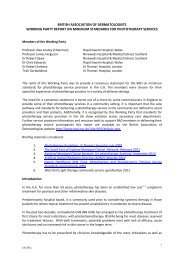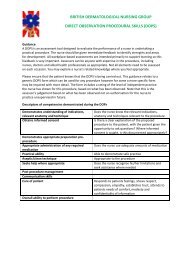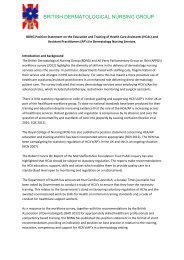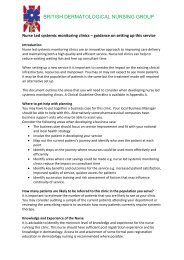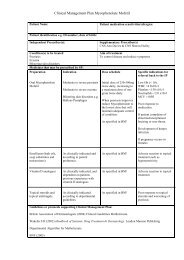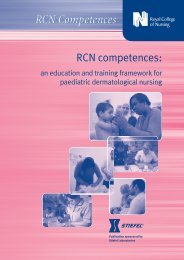Improving outcomes for people with skin tumours including melanoma
Improving outcomes for people with skin tumours including melanoma
Improving outcomes for people with skin tumours including melanoma
Create successful ePaper yourself
Turn your PDF publications into a flip-book with our unique Google optimized e-Paper software.
<strong>Improving</strong> Outcomes <strong>for</strong><br />
People <strong>with</strong> Skin Tumours<br />
<strong>including</strong> Melanoma<br />
Organisation of <strong>skin</strong><br />
cancer services<br />
Table 4. Patients <strong>for</strong> review by SSMDTs<br />
• Patients referred from the LSMDT<br />
• Patients <strong>with</strong> high-risk SCCs (see ‘Glossary of terms’,<br />
Appendix 6) that pose difficulty in management<br />
• Patients <strong>with</strong> MM managed by other site specialist teams<br />
(e.g. gynaecological, mucosal and head and neck (excluding<br />
ocular))<br />
• Patients newly diagnosed <strong>with</strong> MM stage 2B or higher<br />
(American Joint Committee on Cancer (AJCC) staging<br />
system) 26<br />
3<br />
• Patients <strong>with</strong> MM stage 1 or above who are eligible <strong>for</strong><br />
clinical trials that have been approved at cancer network<br />
level<br />
• Patients <strong>with</strong> multiple MM<br />
• Children younger than 19 years <strong>with</strong> MM<br />
• Any patient <strong>with</strong> metastatic MM or SCC diagnosed at<br />
presentation or on follow-up<br />
• Patients <strong>with</strong> giant congenital naevi where there is suspicion<br />
of malignant trans<strong>for</strong>mation<br />
• Patients <strong>with</strong> BCCs that are metastatic<br />
• Patients <strong>with</strong> malignant <strong>skin</strong> lesions of uncertain pathological<br />
diagnosis<br />
• Patients <strong>with</strong> rare <strong>skin</strong> cancers, <strong>including</strong> lymphoma and<br />
sarcoma (see chapter on ‘Management of special groups’)<br />
• For periodic review, patients developing <strong>skin</strong> cancers who<br />
are immunocompromised, have Gorlin’s syndrome or other<br />
genetic predisposition syndromes (see chapter on<br />
‘Management of special groups’)<br />
• Patients needing nodal dissection <strong>including</strong> sentinel lymph<br />
node biopsy (SNB) – these patients should be seen and<br />
referred by the LSMDT<br />
• Patients who may benefit from radiotherapy, if not available<br />
at the LSMDT<br />
• Patients who may be eligible <strong>for</strong> entry into clinical trials<br />
• Patients who require adjuvant treatment (where this is<br />
shown to be beneficial)<br />
26 American Joint Committee on Cancer (1992) Manual <strong>for</strong> staging of cancer. Philadelphia:<br />
JB Lippincott.<br />
58<br />
National Institute <strong>for</strong> Health and Clinical Excellence




